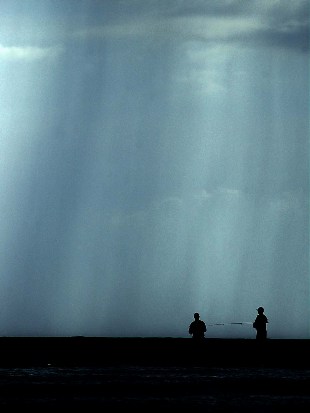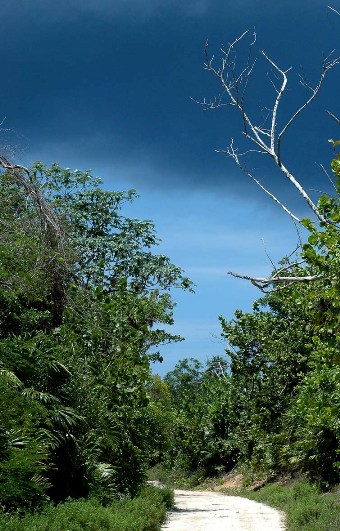Camping & Social Activism
By Dmitri Prieto

HAVANA TIMES, April 21 – Interesting things sometimes happen on Cuban state campgrounds. Located in picturesque areas spread across the island, these camps are run under a national recreation program: campismo, which for a long time have been the only organized leisure activity accessible to “run-of-the-mill” Cubans.
The campgrounds are managed through offices linked to the Young Communist League (UJC), since teens and younger kids are the greatest users the sites. Probably for that reason, the image of campismo is now associated with the scent of rum, reggaeton music and adolescents on the prowl for their first sexual encounter.
One of the campgrounds is located near the town of Boca de Jaruco, in the municipality where I live (Santa Cruz del Norte), only 45 minutes from Havana. Recently there was something very different that attracted several groups of people to this camp.
In mid-March, the third Critical Observatory was held there. This annual conference of people concerned about the future of Cuba is organized by the autonomous Haydée Santamaría Collective under the auspices of the Asociación Hermanos Saíz, which promotes initiatives of young Cuban intellectuals.
The Observatory hardly resembles other meetings of intellectuals-within or outside Cuba. Its purpose is not only to exchange knowledge and discuss research, but also to put people and groups in contact with one another to carry out projects to change much of the negative circumstances that surround Cubans today.
It is a small forum focusing on thought and actions related to issues both here and abroad, since most of the participants are clearly conscious of the global conditioning of many of the situations around us.
The environment: A central topic
On this occasion, one of the central topics of the Observatory was the environment. In the workshop dubbed “Ecolosophy,” research and action projects were discussed; in it, Carlos Manuel Sorzatez, who is from the same community where the campismo grounds are located, gave a detailed analysis about the environmental and social impact of oil exploitation around the Jaruco estuary.
Yaditza Montoya, another Boca de Jaruco resident, analyzed the problems of rural tourism.
Later Marfrey Cruz, the coordinator of Cuba’s Environmental Youth Network, described a civic action that played a protagonist role in an oil spill near Jaruco. She explained how the Network, by monitoring the Cuban ecology through youth teams, was later able to offer the data collected to the Cuban government, which in turn sent it on to UN agencies.
Its focus on “critical complementation” allows the Network to cooperate with traditional institutions while at the same time maintaining its commitment to a new branch of Deep Ecology, a somewhat recent branch of ecological philosophy.
Along this same line, Isbel Díaz presented her “Forest Ranger” urban reforestation project, and Lester Sibyl introduced an ecological blog.
Andrés Mir, the founder of the digital magazine Esquife (Skiff), offered his site to help popularize the Observatory’s proposals and to disseminate other studies.
The issue of the environment continued to be explored in a documentary on the fight against oil companies in Amazonia. The film connected this struggle to the defense of the rights of indigenous peoples and to the global failure in the fight against drugs (as well as the importance of entheogenic plants for traditional approaches to spiritual knowledge).
The film-subtitled by the Our America Cultural Studies Group, which collaborates with the organization of the Observatories-generated polemical discussion. On the theme of the “Americas of the peoples,” there was also a presentation (practically a conference) led by young teacher Fiodor Mancebo, who linked the violent practices of the Maoist group Shining Path to the activism of rural and indigenous peoples and to the history of the Inca Empire.
Likewise, a certain Dmitri Prieto reflected on the destiny of the first social revolution in America-that of Haiti-where, after the overthrow of slavery and colonialism, there evolved a new system of state despotism, which sank the country into a condition of marginalization.
Discussion was also held about the role of communities. Related to this there were documentaries shown on the rescue of Afro-Cuban tradition in Melana del Sur (in Havana Province), how the children of Cocosolo (in the Marianao district of Havana) are learning about the history of their neighborhood (a project of Mario Castillo); and the beginnings, in the 1970s, of the Alamar projects in East Havana (once called the “the city of the future”), presented by Damián Bandín. Two young women from Guantánamo (Yudelys Hechavarría and Aymará Fernández) presented research on how the Catalans contributed to the creation of that city.
Pushing aside dogmatism

Another topic, which is as problematic in Cuba as in other countries, could not be avoided: education. Yadira Rubio and Ernesto Triana, of the El Trencito community project, explained how they have been able to revolutionize children’s games by eliminating the competition factor and promoting cooperation. This is a very new experience in Cuba, though practiced abroad in some other countries.
Rodolfo Peraza demonstrated digital art in the form of video games that use a canon to destroy texts containing “hegemonic speeches extracted from traditionalist manuals of formal education.” If one doesn’t shoot the text it remains still; if you shoot, the letters respond to gunshots.
Legal expert Ahmed Correa spoke about the crime rate among Cuban youth, while in the discussion on university education, arguments were made for greater student advocacy, more academic freedom and the definitive elimination of Soviet-style dogmatism.
The Haydée Santamaría Collective conferred its annual “Enduring Enquiry Award” to several people who had demonstrated positions of civic bravery and solidarity in the defense of activism. One of these awardees was Havana Times writer and professor Erasmo Calzadilla.
The consensus of the Critical Observatory was that today social criticism is not enough, and that the key to desired change has to be found through grassroots activism. This was stressed under the theme “For the society we want, we must construct it ourselves.” As is occurring in other countries, activist networks are also emerging in Cuba.

There seems to be a marked tendency of many cuban critics of the state to see the best future as being 1 defined by this or that petit-bourg. protest movement in the rich imp. countries. These movements however, r only filling the void left by the collapse of working-class leadership in the brutal struggle with the caps. over the future development of Humanity. Socialist praxis — including the relation of the human econ. to Nature — would be far superior to the present capitalist 1, if only it were allowed to develop. Thus the objective nature of the @50-yr imp. embargo: Socialism simply cannot be allowed to flourish: a dagger at the heart of imp.
Also: the history of Ayiti is not the result of its form of govt per se but of the ruthless exploitation of the island after the Rev. thru gunboat diplomacy by europeans, when they sought reparations for the seizure of their plantations etc. So much for non-socialist history lessons from the critics of cuban socialism.
Familia
Este es un ejemplo del empeño continuado de las personas y proyectos comprometidos con la participación, el civismo y el socialismo en Cuba. Por lo que nos toca y lo que alienta, felicidades.
un abrazo